"It is by going down into the abyss that we recover the treasures of life. Where you stumble, there lies your treasure." -Joseph Campbell
One of the bravest things that was ever done with the Hubble Space Telescope was to find a patch of sky with absolutely nothing in it -- no bright stars, no nebulae, and no known galaxies -- and observe it. Not just for a few minutes, or an hour, or even for a day. But orbit-after-orbit, for a huge amount of time, staring off into the nothingness of empty space, recording image after image of pure darkness.
What would we find, out beyond the limits of what we could see? Something? Nothing? After a total of more than 11 days of observing this tiny area of the sky, this is what we found.
The result gave us the information that a very large number of galaxies exist in a minuscule region of the sky.
By extrapolating these results over the entire sky, we were able to figure out -- at minimum -- how many galaxies there are in the entire Universe. I even made a video about it.
So that's exactly what we did, looking for a total of 23 days over the last decade -- more than twice as long as the Ultra-Deep Field -- in an even smaller region of space. Ladies and Gentlemen, may I present to you the Hubble Extreme Deep Field!
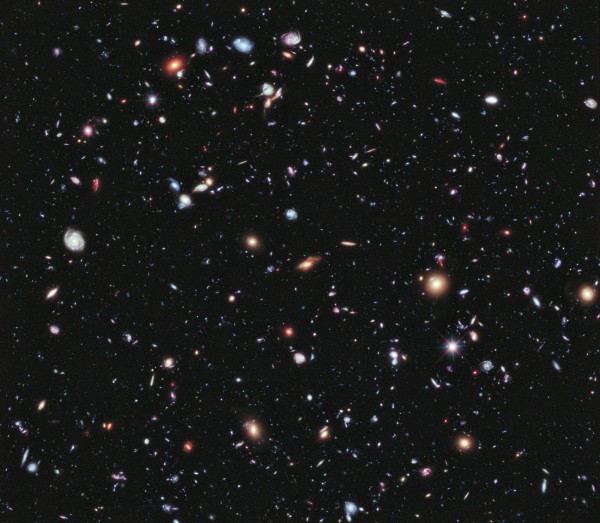
Image credit: NASA, ESA, G. Illingworth, D. Magee, and P. Oesch (University of California, Santa Cruz), R. Bouwens (Leiden University), and the HUDF09 Team.
This picture may look familiar to you, even though you've probably never seen it before. The Extreme Deep Field (or XDF) is actually a part of the Ultra Deep Field, which you can see for yourself if you rescale both images and rotate them at 4.7 degrees relative to one another!
The XDF has far more galaxies in it than the HUDF does in a comparable region of space. Take a look for yourself at a small portion of these images, compared top-to-bottom with one another, and you can clearly see how many more galaxies there are in the XDF with your own eyes.
Sure, the Ultra-Deep one (atop) is very impressive, but there are maybe 75% more galaxies in the XDF! If we apply these results to the entire sky, we find that there are more like 200 billion galaxies in the entire Universe, around double what we got from the HUDF.
How do we estimate that there are so many? For starters, the area of the XDF is just a tiny, tiny fraction of the full Moon.
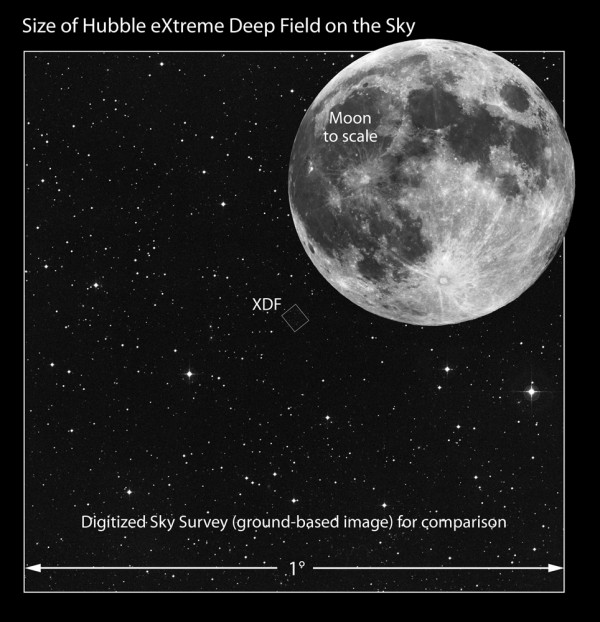
Illustration credit: NASA, ESA, and Z. Levay (STScI); Image by: T. Rector, I. Dell'Antonio/NOAO/AURA/NSF, Digitized Sky Survey (DSS), STScI/AURA, Palomar/Caltech, and UKSTU/AAO.
If you assume that the XDF is a typical region of outer space, you can calculate how many XDFs it would take to fill the entire night sky; it's about 32 million. Multiply by the number of galaxies you find in the XDF, and that's how you arrive at about 200 billion galaxies in the Universe.
But there's more to the story than that.
We're taking a region of space that has very few nearby galaxies, or galaxies whose light takes less than a few billion years to reach us. We've selected a deliberately low-density portion of the nearby Universe. The XDF has found many more galaxies whose light has traveled between 5 and 9 billion years to reach us, which are relatively dim galaxies that the HUDF simply couldn't pick up. But where it really shines is in the early Universe, at finding galaxies whose light has been on its was for more than 9 billion years, finding the majority of new galaxies there.
But even the XDF is not optimized for finding these galaxies; we'd need an infrared space telescope for that, which is what James Webb is going to be. When that comes around, I wouldn't be surprised to find that there are maybe even close to a trillion galaxies in the Universe; we just don't have the tools to find them all yet. In the meantime, I thought it would be fun to allow you to compare the old HUDF image, rotated and cropped to XDF size:
with the new XDF image itself!

Image credit: NASA, ESA, G. Illingworth, D. Magee, and P. Oesch (University of California, Santa Cruz), R. Bouwens (Leiden University), and the HUDF09 Team.
And for those of you who'd rather see the same chunks of these images side-by-side, I've broken them up into four chunks, each of which has the (old) HUDF image on the left and the (new) XDF image on the right.
The scale may be slightly off, but it still provides an excellent visual comparison between the two.
The way light-gathering works is you can typically see 41% as deep when you observe for twice as long, something astronomers are intimately familiar with.
It makes me so impatient for a more powerful telescope with the ability to see far into the infrared, because I can't help but wonder what's still invisible to even the XDF.
And there you have it: the deepest view of the Universe. Ever. What else is there to say? Enjoy them, discover them, and see what you can find in them. It's just the tiniest fraction of the whole Universe, but like you've never seen it before.


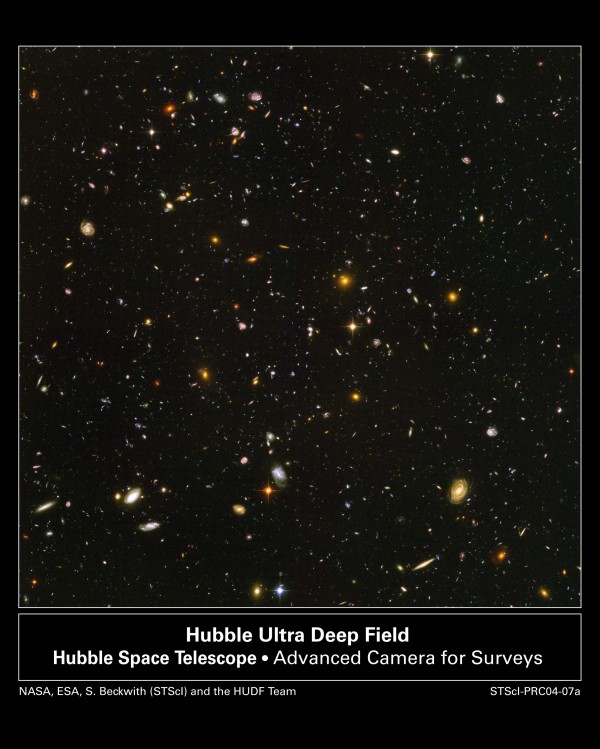


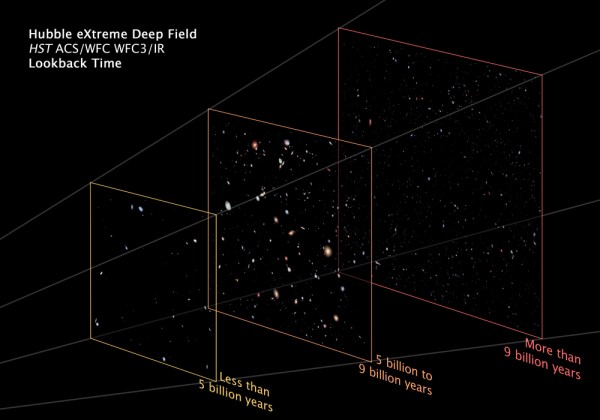
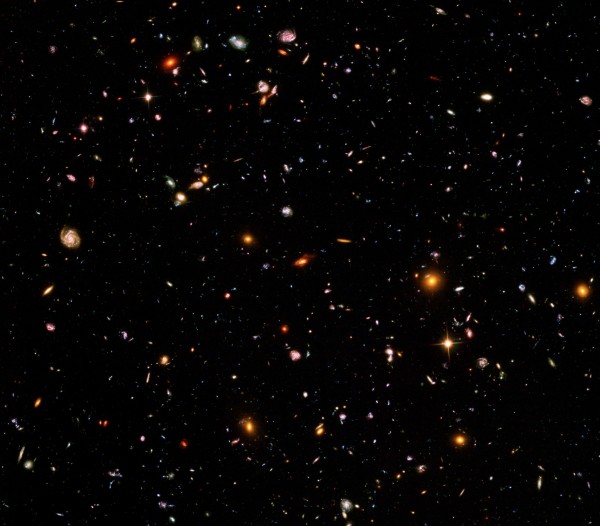
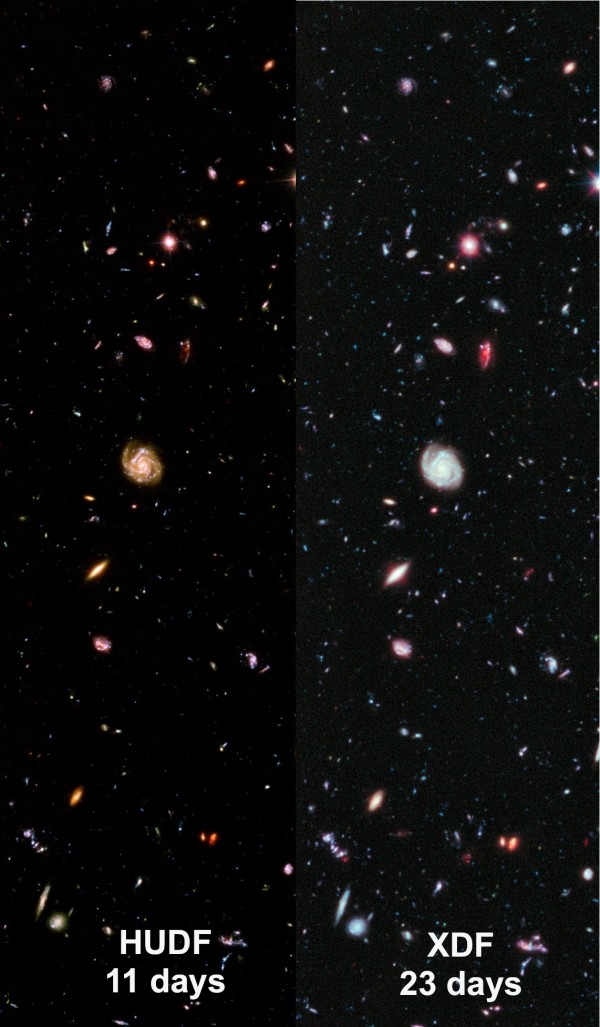
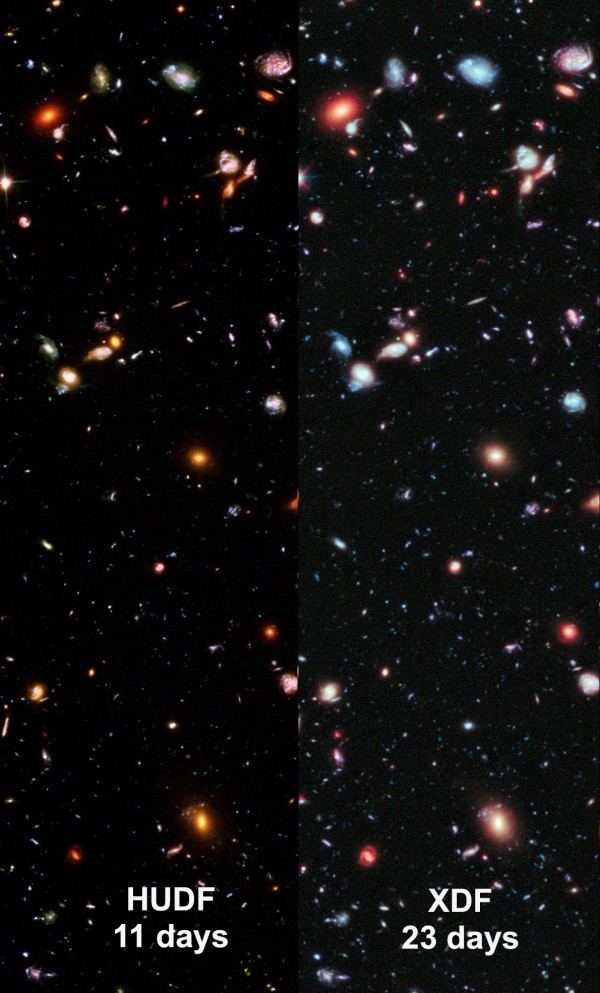
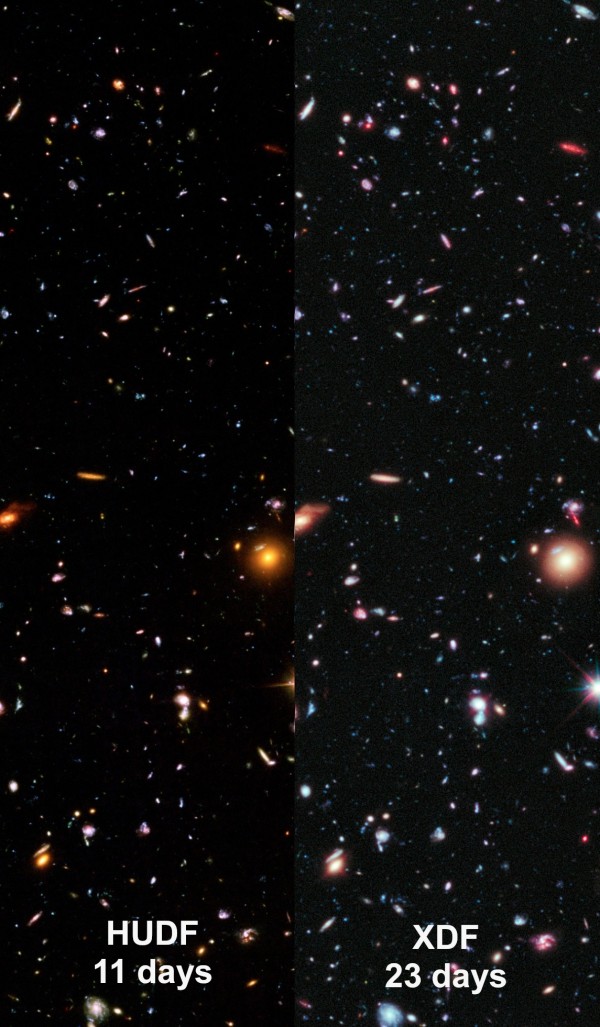
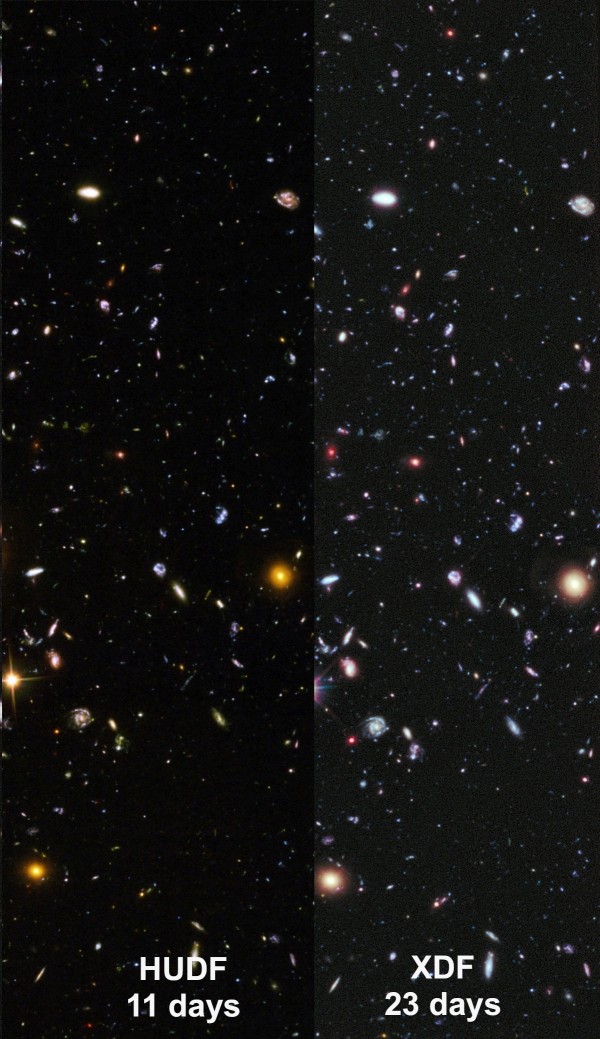
So awesome. But we're still stuck back on earth and low orbit. :-(
The deeper we look the more we find galaxies and more galaxies. If the next telescopes find galaxies at a redshift incompatible with a Big Bang billions years ago, I personnally would be excited to see how the new theories would develop.
The JWST can't lift off soon enough.
it is incredible to see what god has made.
Just ridiculous. I can't look at the HUDF without tears forming in my eyes. Is NASA trying to make me openly weep? Well, good job, then.
Maybe it's just my biased pattern-recognition system, but it seems like there are systematic shapes in the XDF. Do you know if the field is large enough to do a weak lensing analysis (or if anyone has already done so)?
Really an emotional journey into the deep, literally! As you read and look at the photos, when you get to the Hubble Deep, zoom in and experience it in it's full spectrum...or depth! Don't you just feel it?
And speaking of how colors change (and can apparently affect your emotional atmosphere), could you please explain the difference between the blue and the red? I know I asked a question (not directly asking this) years ago, but why does rotating the image cause some red-shifted and blue-shifted objects to swap?
Also, how do astronomers distinguish between the hotter stars from the cool ones when direction is also involved? I would guess there are different spectrums that must be sorted first before determining if what we see is traveling toward or away from us (the listener/observer, what have you).
And just curious, of the galaxies that are undoubtedly traveling toward us, and those traveling away (and since there are so many clummped up), what does this do to space time? Despite gravity and all that, I was mainly wondering how it warps the continuum around it and how that is measured.
Thanks,
A very long time reader from the .com
@Serge: Since the Big Bang happened at a redshift of infinity, it's simply not possible to find "galaxies at a redshift incompatible with a Big Bang billions years ago"...
(well, it's possible to find galaxies at a redshift which are incompatible with the current Big Bang theory - but not in the way you seem to think here!)
We are the bacteria on the paramecium on the mayfly nymph eaten by the minnow that gets eaten by the trout that gets eaten by the kingfisher that gets clipped by the hawk. Actually, we are dozen or so orders of magnitude smaller than that.
This makes me think about something not related to deep field, but some consequences of it. Here is my question.
Is it my misconception or is our understanding of the ratio of baryonic matter/DM and DE changing heavily in the past 2-3 yars.
Couple of years back we all heard 5%BM - 25%DM - 70%DE (give or take couple of %). So what changed... well the studies on the effects of relativity in galaxy rotations (most papers I read conclude that there is a significant gain of mass/energy from relativistic effects that don't show in newtonian calculations), now with extreme deep field, our count of galaxies just went from billion to trillion (and will probably keep rising), new discovered large H gas areas of interstellar space etc... My question is are we starting to look at something like 25% BM - 25% DM - 50% DE?
@ Sinisa Lazarek - I believe Ethan covered your question in one his earlier posts. This discovery does not alter the ratio of baryonic matter: dark matter and dark energy.. It just means that more of the baryonic matter is in the form of stars and galaxies instead dispersed into clouds of hydrogen
200 billion, with a bloody 'B' no less. And complete galaxies, not mere solar systems. Based on what little I know about planet surveys wouldn't that imply trillions of planets? Even if earth-like planets were exceedingly rare it makes me think there still might be quite a few of them.
Not that I will ever get anywhere near them. Sill ... an amazing thing to know, and a wonder to have the privilege to be alive now to get to know. That is, and should be enough but still a bit sad. Something for future generations to figure out.
Options for travel include the two classics, generation ships, and FTL travel, with the later having a good chance of being impossible. Even given the slow boat to China scenario, and given my age, I'd still jump at the chance to be one of several thousand to participate.
In an entirely different vein, are there any estimates on how many might be duplicates due to lensing and how many might be being concealed by dust clouds or other barriers?
Thanx Pranav,
I forgot about WMAP and Baryon Accustic measurments.
But going from 100 Billion galaxies to 200 billion galaxies estimate has to change something fundamental, maybe:
- the time required for a galaxy (stars and even planets) to form after the big bang
- our estimate of the curvature (flatness or not) of spacetime
- maybe even the big bang is at risk and we just have eternal inflation as far back as we can see
Because all of the additional 100 billion galaxies are beyond the limit of previously know galaxies.
So, call me naive, the picture has changed so significantly that the Big Picture Story has had to change somehow too.
So what has changed.
And the answer Kale gave above
"Ethan covered your question in one his earlier posts. This discovery does not alter the ratio of baryonic matter: dark matter and dark energy."
seems correct (because dark matter of milky way is a relatively local phenomenon). But something has to change.
So what big part of the story has changed to account for a doubling of the number of galaxies in the universe? And whatever we say needs to be able to explain the next doubling and the next etc that may be possible with the James Webb.
So what are the possible big story changes?
I mean we now have, "5,500 galaxies, many of which existed shortly after the birth of the universe. The farthest-away galaxies are 13.2 billion light-years from Earth, meaning.. according to a NASA statement. "The youngest galaxy found in the XDF existed just 450 million years after the universe's birth in the Big Bang."
I know those dots on the XDF image are just specs to me; but to the specialist armed with super analysis programs maybe they can tell if some of the new galaxies spirals. I mean forming a sprial galaxy takes longer than forming an elliptical galaxy doesn't it? Is 450 million years enough to form a spiral?
So please educate me or not. Thanks.
@ OKThen
Seems that we share the same question in a way. Initially I thought that the way we get observed baryonic matter density is by counting galaxies in a given area, and then extrapolating that to the whole size of observable universe. This is one way to do it but BB nucleosynthesis theory gives very clear ratios and numbers and this has been pretty much confirmed experimentaly, except i think for lithium which isn't as predicted. Then there's observational data from WMAP and accoustic oscilations. So there's basically 3 different things/observations which confirm the model. Interestingly the majority of baryon mass seems to resides is huge clouds of H around galaxy clusters. The galaxy masses are a "relatively" (i mean we're talking trillions :) ) small contribution to overall mass.
Now as far as "new" galaxies... in a way it's innevitable to happen. I mean the further time passes (and I mean our life span), we are gonna see more and more galaxies since the light from them is going to reach us, which previously hadn't. In a way I think of it of observational evidence for growing universe :)
What I didn't however find is what number in terms of mass BB Nucleosynthesis predicts when feeded the data from WMAP. How many millions trillions of Solar masses ie.? I see the results from WMAP obervations.. but they are direct measurment of what we see. What I can't find in real numbers is how much does theory say Universe "weighs" in terms of baryonic matter.
@husker fanatic - [citation needed] evidence?
I´m still not finished looking at those "photos" side by side.
Incredible.
... and two thirds of our world are starving to death...
The earth will be fine.
SL part of the calculation of DM is predicated on the rotation curves of visible matter in the galaxies we see.
Seeing more galaxies doesn't change that part of the equation.
@Xxxxxxx
You are so right!! Hubble is a bitch!
Now read this and be humble towards Hubble:
http://ipp.nasa.gov/innovation/Innovation41/HubbleFights.html
Have a nice day.
there is so much to look forward to,,, yet so much of which to be ashamed...
@ Wow
that's true, but the proportions on the overall density of the universe might. As well as the amount of DM needed in halos. Not saying DM is eliminated or that it should be, but am asking if the ratio's are being changed. For galaxy rotation, it seems we got back some "missing" mass just by applying relativity to previous calculations. So there might be less DM then we think.
Wow. Just wow . . .
Ethan (or whomever has the answer),
Some galaxies are a combination of several earlier galaxies. Correct? So when we look at images like the UDF and the XDF we can reasonably assume many of the galaxies have coalesced by now, especially the older galaxies, correct? Why then are we basing our estimation of the number of galaxies in the universe on the number of galaxies in the images? Don't we have to take into consideration the fact that many of these galaxies have combined by now? Of these 200 billion or so galaxies what percentage of them would you estimate have combined with another galaxy? Am I missing something? (I don't mean to detract from the mind boggling numbers. They are mind blowing even if you cut them by 75%.)
@Sinisa Lazarek:
That claim looks strange to me. Why should relativistic effects be important for galaxy rotation curves? Neither are the speeds around the galactic center close to light speed, nor is the gravitational field of the galaxy particularly strong.
Could you provide some citations, please?
WRT your question if the ratio of BM to DM has changed due to the increased galaxy count: the new observations have increased the possibility to see very distant objects (see the illustration about "Lookback time"). Hence the new estimate of 200 billion galaxies is with respect to a much larger volume than the previous estimate of 100 billion galaxies, not with respect to the same volume! And hence you can't conclude that the baryonic density is twice as much as thought before.
@Bjoern
Thank you for the answer, and indeed pointing to volume also increasing.
As for links to relativity and galaxy rotations. Here they are (might need to post in several messages cause of link limit per message)
The original work I found was by Cooperstock and Tieu in 2005 or so.
http://arxiv.org/abs/astro-ph/0610370
and
http://arxiv.org/abs/1101.3224
they argue no DM is needed, which I found to be seriously refuted by others. But the principal to use Einstein equations instead of Newtonian has been proved to yield some 30% of mass. (link in next message)
this is the link for relativity giving different mass estimation than newtonian dynamics
http://arxiv.org/abs/astro-ph/0602519
conclusion from the last paper:
"4. Conclusions
Using a simple model for a galaxy we could show that the Newtonian approximation over-estimates the amount of matter by about a third, whereas GR reduces the amount of dark matter needed to explain the flat rotation curves. This does not imply that exotic dark matter does not exist as insinuated by {6}. After all, dark matter is a “500% effect” (meaning that there is about five times as much of
dark matter in the universe as ordinary matter) and there are several independent measurements and arguments which suggest the existence of dark matter, e.g. from
microlensing {15}. But as astrophysical measurements reach unprecedented accuracy the unexpected GR correction in the 30% range predicted in our paper certainly
will not be negligible...
Bjoern
The problem is:
The previous 100 billion galaxies were observed within the 12 billion lightyears radius in which galaxies were observable.
The additional 100 billion galaxies are observed further out beyond the 12 billion lightyears radius and before a 13.2 billion lightyear radius. Hence these 100 billion galaxies for the most part are much older than any galaxies observed.
Hence my questions, how does the big picture story change?
Since no one has answered yet, I assume the answer is: We don't know yet. That's OK, I can wait.
OKThen,
There is a mix of where the new galaxies are found. While it's true that some are found beyond the 12 billion year lookback time, it is by no means most of them. As the "lookback time" image by NASA, ESA, and Z. Levay, F. Summers (STScI) shows, most of the galaxies in this 5,500 are between 5-and-9 billion years (lookback time), they are just very faint compared to the ones that also appeared in the HUDF. Yes, there are more out beyond the 9 billion year mark too, but nothing that invalidates (or even causes us to question) our current understanding of structure formation.
Siniza,
The baryon density cannot be changed much, thanks to nucleosynthesis and WMAP. The percentage of the Universe's energy that is locked up in baryonic matter is around 4-5% and can't be outside of that range.
Dark matter is constrained by a large number of sources far more powerful than individual galaxies, including the CMB and large-scale structure formation (where the density fluctuations on large scales are still less than the background density, and the perturbed GR solution can be explicitly calculated). There is more uncertainty there, but all number point to a total DM density between about 17-30%. When we put up that WMAP pie chart we sometimes act like we know that "22.6%" or somesuch part of the Universe is dark matter, but it is not known that precisely.
Hope this helps.
@Sinisa Lazarek:
The stuff by Cooperstock et al. has been mentioned by Ethan already some times - his conclusion: what they model there simply aren't galaxies, so these papers say nothing about DM in galaxies.
@Ethan,
thanx for answering about the proportions. It helps indeed :)
@Bjoern
I agree that Cooperstock's model is disproved, but his model looks to go without DM in total. Therefore I linked the second one from H. Balasin, D. Grumiller which I find more interesting, if for nothing else, then to show that if we can model something with more "modern" theory, we should cause our intuition might not be correct all the time (intuition here being that newtonian formula is enough to model galaxy rotation). But yes, it's still a very open discussion if it's the right way to go or not.
@Bjoern
p.s. forgot to say that, of course, it's a simplified model, and it assumes galaxy behaves as a rotating fluid. But I find it interesting since gravity is still not completely understood and think there are still important discoveries about it. I don't hold MOND in high regard, but if relativity on it's own can shed some new light into something which was usually calculated classically, I'm curious :)
Ethan
Thanks for the clarification. That's what I needed to understand.
Sinisa Lazarek
I like Cooperstock's work. His book http://books.google.com/books/about/General_Relativistic_Dynamics.html?… is a worthy read.
I'm convinced. The trouble is, that his peers aren't convinced.
Recently I came across a report (Wenceslao Santiago-Germ´an http://arxiv.org/pdf/1112.1179v1.pdf) in which general relativity behaving as a kind of superconducting gravity explains dark matter. I emailed Cooperstock, suggesting that Santiago-Germ´an superconducting general relativity equations must dovetail mathematically with Cooperstock's theoretical models because both use GR to explain DM.
Cooperstock emailed that he'd look carefully at it.
Wenceslao Santiago-Germ´an says, "under very precise astrophysical conditions—the Einstein general theory of relativity is formally equivalent to the Ginzburg-Landau theory of superconductivity... If this hypothesis proves correct, the whole phenomenon of dark matter may count, after all, as another triumph for Einstein’s theory of gravity."
All sounds well and good, but!!!!
But until the general relativity experts and the astrophysicists community agree; neither Cooperstock nor Santiago-Germ´an have anything.
However, I'm following both of them. Two different approaches using GR have (in the authors' minds) explained DM. That adds more credibility to their method. But!!!!! there is a lot of detail data and facts that needs to be correctly accounted for, and only the experts can decide that the theoretical work is sufficient.
So far it is not, so dark matter is unexplained. I don't believe that Cooperstock or Santiago-Germ´an are disproved; rather their work is not yet of a high enough calibre to be accepted.
But I am still following their work and wishing them the best.
"Hence the new estimate of 200 billion galaxies is with respect to a much larger volume than the previous estimate of 100 billion galaxies, not with respect to the same volume! "
Although that volume is from our POV, not that of the universe at the time the galaxy emitted its light along with its peers. It used to be smaller and that volume has been stretched because of our location in time.
Additionally, because of inflation, the universe at that time used to be heavier (less matter had managed to move beyond the visible universe horizon). AFAIUI, these effects are guestimated at having taken place, but they do make assumptions that can be wrong.
I'm happier with using the CMB to limit the amount of matter of all types just as I can take the limit of MACHOs (brown dwarfs and orphan planets etc) being set by the fact that if they were numerous enough to explain the discrepancy, there'd be so many we'd be unable to miss them occluding other stars.
Physics, Nature, is awesome. The numbers in physics are so extravagantly large, small, different, describing God's Nature in a way beyond imagining. Alice in Wonderland stuff. Entirely counterintuitive. All nature, really. Chemistry, Biology, all of it. Sure beats disgusting amoral bs politics.
As the wise woman said, "It's turtles all the way down!"
I bet the turtle on the bottom is complaining about the infinite weight of turtles he has to carry...
Gee, does that mean that the turtles must have shells made of a material with a yield strength of infinity? Are all the shells made of this stuff, or just the turtle on the bottom?
If there are an infinite number of turtles, wouldn't every turtle have an infinite number of turtles on top of it? Also... with respect to our low-content godly annotators, I too am in awe of the mighty works/sneeze remnants of the Great Green Arkleseizure, PBUH. May the loving grace of Xeeno's paradox ensure his handkerchief remains ever half a universe away
Enki,
Things get very counterintuitive when inifinity is involved. There would be some turtles who would only have a finite number of turtles on their backs. To see this, realize that the turtles could be put into one to one correspondence with the natural numbers. The turtle that is holding up the earth directly would be number one, the next one down, number two and so on.
Now, the number of turtles on top of a given turtle would be equal to the number of natural numbers less than the natural number to which the turtle corresponds. Thus, the first turtle would have zero turtles on its back, the next one down would have one and so on.
Now, I'm not a mathematician, but here goes with a proof that despite the fact that there are an infiinte number of turtles, no single turtle actually has to support an infiinite number of turtles on its back. Let N be the natural number corresponding to an arbitrary given turtle. Therefore, we can work solely with natural numbers and forget about turtles. We need to prove that for any given N, there are only finitely many natural numbers less than N. Proceeding inductively, let P(n) be the property that there are finitely many natural numbers less than n. Obviously P(1) holds since there are zero natural numbers less than one. Assume that P(n) is true. Now since P(n) holds, let k be the finite number of natural numbers less than n. Since there are k natural numbers less than n, there would be k+1 natural numbers less than n+1 (namely the number n and all of the k numbers less than n). Since k is finite, k+1 is also finite. Therefore P(n+1) holds, so by mathematical induction P(n) holds for all natural numbers
QED.
Now I know that I am truly a geek since I've turned a joke into a formal mathematical proof. :)
Although if your turtle had a shell that increased in weight linearly with the strength of its material, then your bottommost turtle would have a mass infinity squared above it.
Plus the earth.
Now it's getting truly geeky in here :) Love it!
Two points about DM and galaxies:
Most observations are about ratios, not total mass of DM or BM. More visible galaxies would lead to an expectation of more DM in those galaxies at similar proportions ad found elsewhere.
A recent survey to find more MACHOs failed to find them in spiral galaxies, but found many in elipticals, where previously the visible plus predicted DM mass did not add up to the observed gravity. Finding extra normal matter helped non-normal matter DM theories.
It's the "plus earth" that's the killer. The planet that broke the turtle's back, as it were.
@Mike
Assume galaxy collisions are roughly evenly distributed, which isnt much more of a stretch than assuming this section of sky is representative in the first place, and it all works out.
Bullfeathers. In all that distance, we still can't see Mitt Romney's tax returns?
This is probably one of the most interesting things I've read, ever. However, does this not bode bad news for those who still hold out hope we might someday beat the speed of light? Consider this, you can apply a kind of 'inverse Fermi's paradox' here - the observable universe must be teeming with life (180 billion galaxies multiplied by hundreds of millions of stars per galaxy), so if faster than light travel were possible, surely 'they' really would be simply everywhere by now, all over the place? This is thus simultaneously one of the most exciting things I've ever read, and one of the most depressing .. all those galaxies, and most of them probably out of reach indefinitely.
proberbly there is life on the other solar system around other stars that are also like the SUN. the bible only defines everything as stars, is earth the only one with life in it. the milky way is huge more than the word. theres more we dont know which we not supposed to know about creation.
Can anyone explain a few basics of astronomy to an appreciative neophyte ?
1. How is it that we can "see" a sharp image of a galaxy whose light has been traveling through space for billions of years? Why is is that the light does not disperse, fade away, or at least lose its sharpness? Is it because there is a vacuum and little or nothing (no atmospheres ) to refract or break up the light?
2. Is the galaxy light we are seeing,however old it is, light generated by each of those galaxies, and not mere reflexions of light?
3. I'm not sure what you mean about the "red shift" effecting our ability to see these galaxies.
4. How is the light from these galaxies different from the spectrum of visible light we see with the naked eye?
5. When we look at these pictures are we seeing an image that is converted so that we can "see" it with our eyes?
@George #53: Here are some simple explanations. Your best bet for better information is to go to Wikipedia and lookup the appropriate keywords. The physical sciences, including astronomy, are generally factually accurate, and much less prone to vandalization or wackos than more "political" topics.
1. Exactly. The density of interstellar and intergalactic space is so low (about one atom per cubic meter), and the probability of light interacting with atoms is so low (the "cross-section") that most light travels right on through without doing anything until it gets to our atmosphere. If you want to see what happens when that isn't true, just look at the Milky Way in the sky. All of that diffuse glow is caused by clouds of dust and gas, which block our view of the rest of the galaxy.
2. The light from galaxies is direct. Look up "light echo" to learn more about what real astronomical "reflections" look like, and how they behave. There are (many) cases of multiple images of the same galaxy caused by gravitational lensing (look that up, too).
3. Suppose a galaxy naturally emits mostly visible light (red, blue, yellow, green, etc.). A high redshift will push those colors (wavelengths) down into the infrared or below. Unfortunately, not only do our eyes not see infrared, it doesn't get through our atmosphere either (see "greenhouse effect"), and so we won't see much of that light through our ground-based telescopes. Of course, galaxies do emit UV and soft X-rays, which can be redshifted down into the visible. So you need to do some math involving the overall spectrum, how that whole spectrum gets shifted, and what parts of it can make it to the ground.
4. See #3. You may also want to read "Astronomical spctroscopy" in Wikipedia.
5. That depends. If the image was simply captured with a camera on a ground based telescope, then it'll be approximately visible light. But the intensity is generally so low that your eye wouldn't see much if you looked directly (think about a long-exposure film photograph). For parts of the spectrum outside the visible (IR, UV, X-rays) the actual data has been processed and assigned "color codes" corresponding to either energy (frequency) or particular chemical spectral features, and so the picture you see is constructed.
Simply mind-boggling.
Fun fact I figured out: how many Toyata Prius's could you fit in the universe?
A billion
Times a billion
Times a billion
Times a billion
Times a billion
Times a billion
Times a billion
Times a billion
Times a billion
10 to the 81st power, give or take an order of magnitude or two.
On one hand I'm excited because there's well over a 99% chance of alien life.
On the other I'm sad because:
a) We can't move faster than the speed of light and will never be able to travel to some of these universes, and
b) Some jihadist or short-sighted bigot will probably turn the key and kill us all before we can really spread out to other planets. Depressing.
On the bright side, assuming that the universe functions in a cycle of expansion and contraction, give it a few billion years and the far-off galaxies will start coming back together again! Yay!
Astonishing! Absolutely astonishing!! It's almost impossible for a puny, human mind like mine (and yours) to come to grips with 200 billion galaxies. It also seems utterly, ridiculously, absurdly idiotic to believe that life, including maybe REALLY intelligent life like Babylon 5's Old Ones, isn't out there somewhere. In the meantime, with so many more galaxies in the heavens than there are humans on Earth, could I maybe have my own galaxy? It doesn't need to be a big one. Just a nice, little spiral maybe 50,000 LY across. No globulars, please. They're messy...
OK, how about we shitcan this "neurologica blog" to show spamming doesn't pay.
We must realize that what we call space is boundless and infinite - therefore, the universe is much, much larger than we can see. The universe probably is trillions of light--years in size, extending into infinity.
This is breathtaking to see.
I had some spontaneous questions and thoughts although I do not have any knowledge in astronomy or physics so excuse the naivety.
In regards to how this tells us about the amount of galaxies there are in the Universe it only tells how many Galaxies are in the range of their light reaching earth during the time the light has had to travel. Right?
Isn't that what is called the observable Universe, which has nothing to do with the limitation in size or content of the Universe as such but only to how far we can see "through it"?
On every dark spot on these images there could then be an infinite number of galaxies whose light is any amount of light years away from reaching earth. Right?
So our observable Universe grows with time as light from more and more distant galaxies reach us? Or does it work like that at all?
Also in regards to this photo being a spot that was previously dark on shorter exposures and then almost doubled in the amount of visible stars when doubling the exposure(or whatever it was they did) Shouldn't it then be assumed that this process could be repeated again and again with a better telescope, longer exposure times and smaller crop?
What makes you believe that we are approaching to see the full density of galaxies in these images?
Thanks,
S